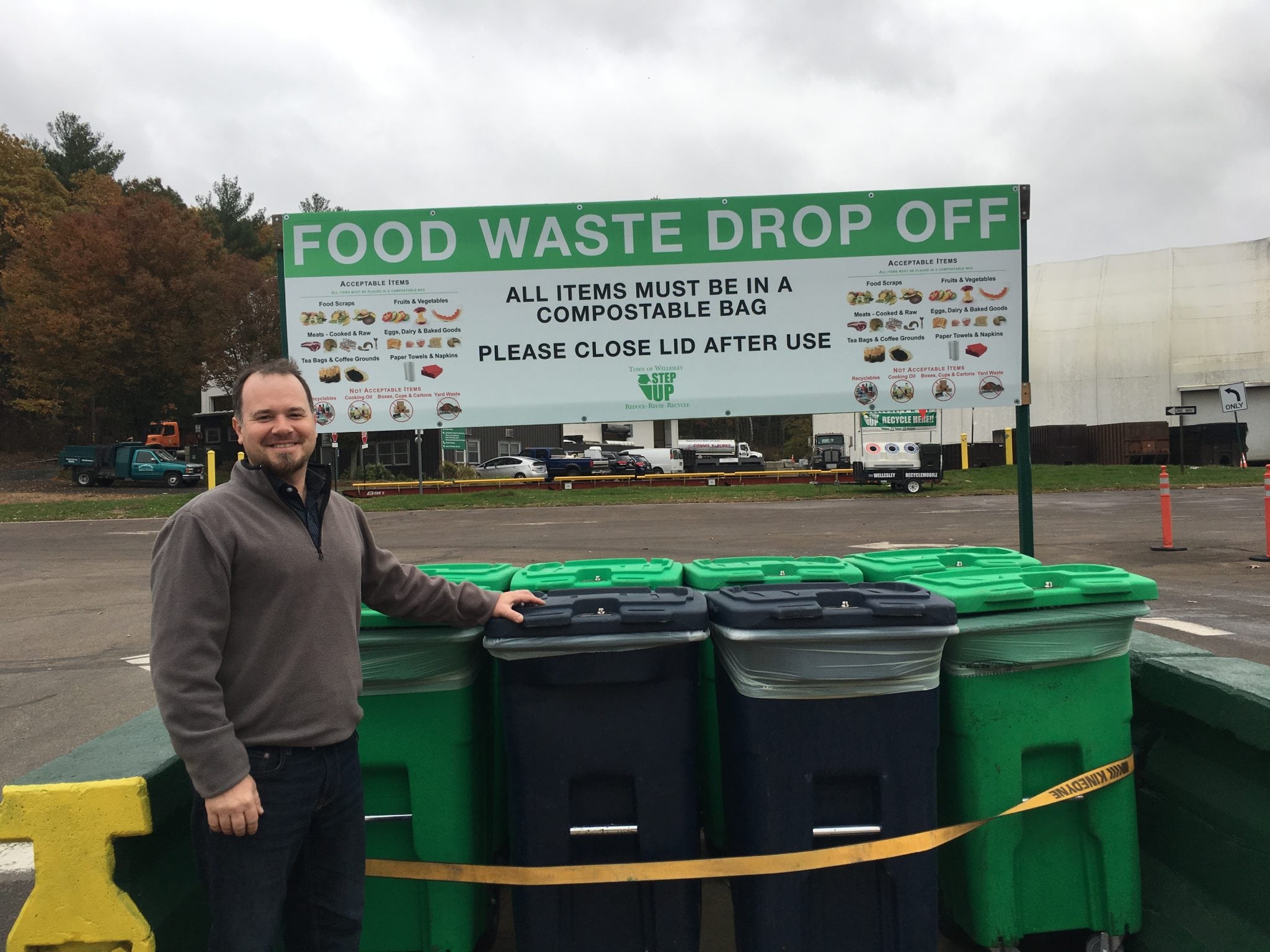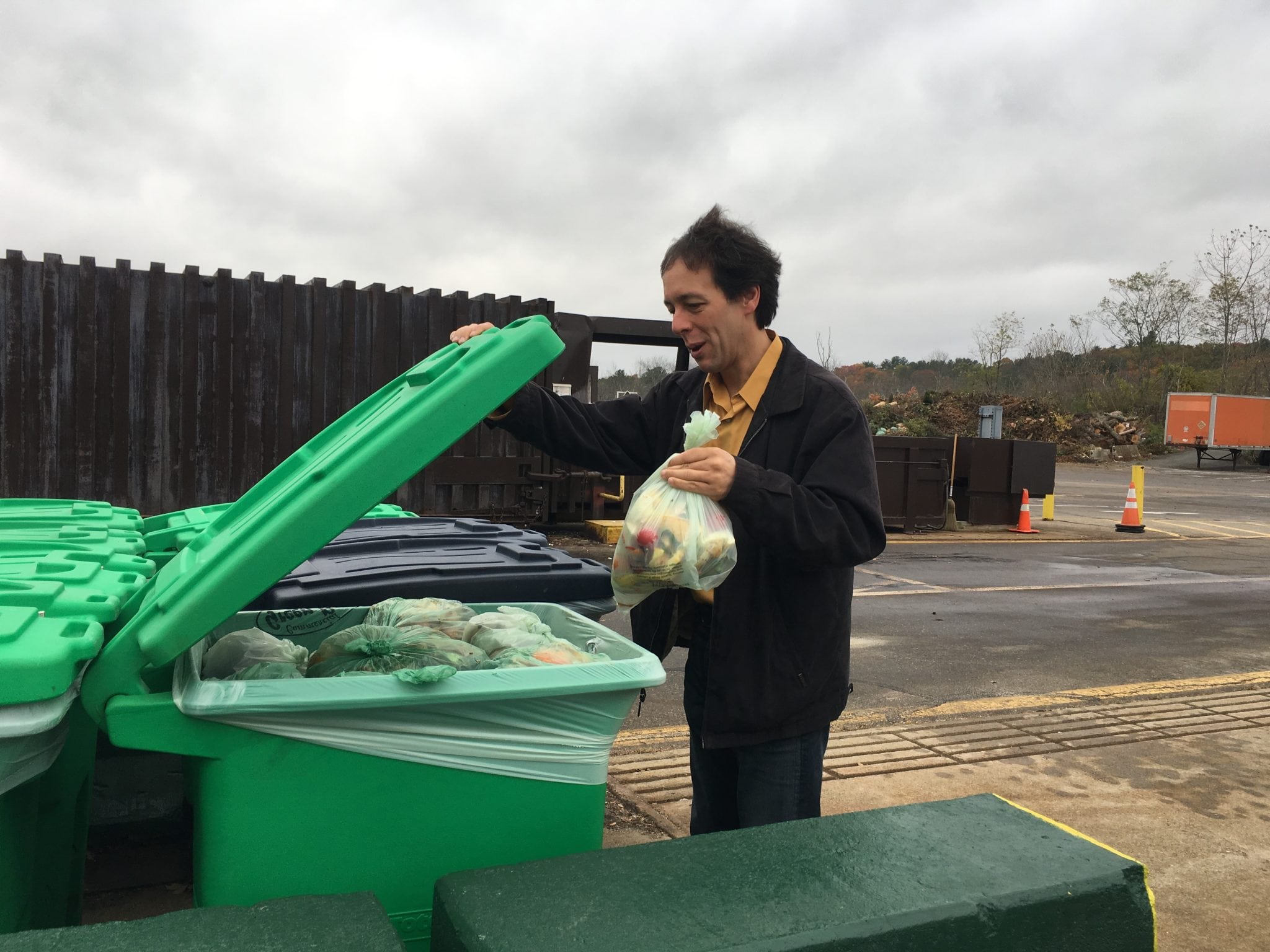The Wellesley Recycling and Disposal Facility (RDF) and 300 lucky Wellesley households last month started piloting a new food-waste disposal program in an effort to gauge interest in and feasibility of opening such a thing up to all residents. The program went live on October 10 and runs until January 10. A few weeks before the pilot ends, the Board of Public Works will decide whether to continue the program that the Department of Public Works, the Natural Resources Commission, and the Sustainable Energy Committee — which make up the 3R (Reduce, Reuse, Recycle) Working Group — helped make a reality.

We’re one of the 300 families who have been busily scraping our fruits and vegetables; tea bags and coffee grounds; cooked and raw meats; eggs, dairy, baked goods; paper towels and napkins into our RDF-supplied kitchen-countertop bins. I’ve been waiting for years for this program to come around, so you could say I was a True Believer before I even got my starter kit, paid for by Massachusetts Department of Environmental Protection grants, which included a counter top bucket, compostable bag liners, and a container for transporting my food waste to the RDF. Even without all of these presents they pretty much had me at “waste management.”
I stopped by the RDF office to check in with Superintendent Jeff Azano-Brown to see how the program is going.
Who are the players?
According to Superintendent Azano-Brown, there are three major outside players in this program, all in Massachusetts — Waste Management‘s CORe (Centralized Organic Recycling) facility in Charlestown; the Greater Lawrence Sanitary District; and Save That Stuff, the company that comes to the Wellesley RDF and does the hauling.
For a fee of about $150 – $165 per ton, Save That Stuff collects the food waste that the pilot program participants put in rodent-secure barrels. If there is a fee, it doesn’t sound like we’re saving money, and Azano-Brown confirms this. “Hopefully it eventually will,” he says. “Not now, however. We pay for the service of the barrels coming to be emptied. We pay $15/barrel every time they come. As a basis for comparison, our cost for trash removal is $77.50/ton. As an additional comparison, we pay substantially more for electronics than if we just tossed them. Televisions cost $520/ton for removal, but we pay it of course because it is a Waste Ban item in Massachusetts, and it is the environmentally correct thing to do.”
What happens to our old, gross food?
After Save That Stuff collects our potato peels and moldy brie cheese, it goes to the Waste Management facility in Charlestown. There, they make it into an engineered bio-slurry. Apparently, this slurry recipe is ever-changing as the technology for the most efficient way to deal with the combination of foodstuffs evolves. Azano-Brown notes that it’s a burgeoning technology that is quickly changing. What hopefully is not changing, however, is the company’s commitment to food waste management, since Wellesley isn’t keen on the potential inefficiency of having to skip around from company to company until they find one that sticks. “This company’s model seems like it will be stable for at least the near term. We don’t want to keep changing around,” says Azano-Brown.
How did Wellesley become waste management BFFs with Lawrence?
After the slurry is good to go, Waste Management’s tanker trucks filled with the slurry go to the Greater Lawrence Sanitary District (GLSD). In Lawrence, the slurry gets mixed in with the sewage sludge from the towns served there — Lawrence, Methuen, Andover, and North Andover, and Salem, New Hampshire. The GLSD’s stated mission: “to preserve and protect the Merrimack for enjoyment and use both today and the future.”
GLSD then captures the methane that is produced from the raw mixture of a combination of the slurry and the sewage sludge material and uses that captured methane to offset their power costs. Once the methane is captured, GLSD dries out the slurry-sewage sludge material and it gets used on farms as a low-fertilizer, meaning one that is slowly released and depends on moisture and temperature to release nutrients. The slow-release nature of this type of fertilizer lessens its leaching into waterways during heavy rains.

So this isn’t a composting program?
“What we’re doing with this program is not composting,” says Azano-Brown. “It’s a food-waste management program. This is an important distinction, and it’s one of the reasons why we are able to use raw and cooked meats in this program.”
Azano-Brown is ever-mindful that landfill space is, well, filling up. “Food waste is 20 – 30% of our residential trash stream. By using a food waste program such as this, we really have the opportunity to slow the pace of filling landfills,” he says. “We’re currently doing a ton of food waste per week.”
So with 300 households currently participating, that’s about seven pounds of food waste per week, per household. With about 8,500 households in town, if the program went town-wide, the potential would be vast, to the tune of over 50,000 pounds of food waste per week diverted from landfills. Azano-Brown notes, however, that “We will encourage all residents to participate, but we have no intention to make this a mandatory program, and at this time there are no plans for the State to move in that direction, thereby compelling us to do so. It will be comparable to our other optional programs,” such as separating boxboard and chipboard from corrugated cardboard and tossing your tin cans and plastics in the proper sorting bins in the recycling area.
Right now, State law does not allow items into the trash stream such as lead batteries, leaves, tires, glass, cathode ray tubes, asphalt pavement, brick, and concrete. Household food waste is not on that list. So if the Wellesley RDF food-waste program sounds to you like just one more thing you have to do in this crazy world, don’t withhold your support just because you don’t want to join in. But I will tell you, at my house we’ve found it the easiest thing to integrate into our daily lives and regular dump trips. Not that I’m trying to pressure you, or anything. If you’re into it in theory for people like your neighbors, but maybe not quite ready for the practice of it all yourself, you could say as much on the support page link.
What about rodents?
Well, sure, they exist. And, yes, the RDF has an active rodent-control program already in place. However, the food-waste management program has not resulted in additional rodent activity at the RDF according to Azano-Brown. The bins are on serious lockdown and require opposable thumbs to operate. In fact, I find it a trifle challenging to open the lid mechanism (with my opposable thumbs), hold open the lid (it’s a little heavy), and toss in my food waste all at the same time. When the really cold weather hits, I’d better not have to take off my gloves to work that doo-hickey that keeps the bins secure. Adding to the RDF’s commitment to clean, checking the barrels at night to make sure they are securely locked has become one of the staff’s nightly housekeeping chores.

What next?
The pilot program goes until mid-January. A few weeks before the end of that phase, Azano-Brown says, “The Board of Public Works will decide how or if it will continue and branch out to the rest of the town.” A big part of their decision will likely ride on whether the program proves to be clean and easy for residents to use, and whether the Board believes the $150/ton removal fee is a good way of spending Town resources.
The RDF returned $798,000 to the general fund in FY 2017 through the sale of recyclables, commercial trash fees, earth products sales and fees, and commercial snow permits.



Mixing food waste with sewage sludge does not make it less harmful for land application. Every entity connected to a sewage treatment plant can legally pipe its hazardous chemical compounds into these facilities where they concentrate in land applied sludge (biosolids). Experts have identified sewage sludge as the most pollutant rich mixture of the 21st century. Over a hundred U.S. and Canadian farm, environmental, and health organizations– led by the Sierra Club– oppose land application of biosolids. Researchers at the Cornell Waste Management Institute, who have studied land application since the 1970s have stated that the current U.S. regulations do not protect human health, agriculture, or the environment.
Government agencies have known for decades that land application of sewage sludge is harmful. Mixing sludge with compost changes nothing about the risks. Gardeners, landscapers and farmers might want to think twice before spreading this contaminate waste on their land.
For a partial list of hazardous chemicals found in sewage sludge, refer to http://sludgefacts.org/Ref125.pdf
Hi Caroline, this notion that biosolids cannot be safely used in the farms is not widely supported by the scientific community. Here are just a few of the many links you can find online:
https://www.npr.org/sections/thesalt/2013/05/07/182010827/is-it-safe-to-use-compost-made-from-treated-human-waste
https://www.washingtonpost.com/lifestyle/home/would-you-use-human-waste-in-your-garden/2017/08/22/43556b90-82b4-11e7-b359-15a3617c767b_story.html?noredirect=on&utm_term=.b1affdec5504
https://modernfarmer.com/2014/07/stink-human-poop-fertilizer/
What happens to all the compostable bags then if it’s not being composted? Don’t they get thrown out in the trash at the CORE?
Seems like composting is better than sending it to sewage sludge.
Very interesting…Is this process different than sending food scraps down a garbage disposal?